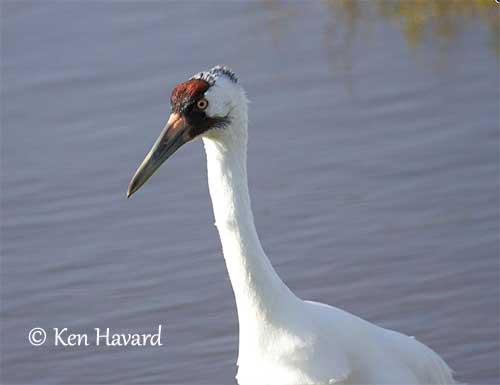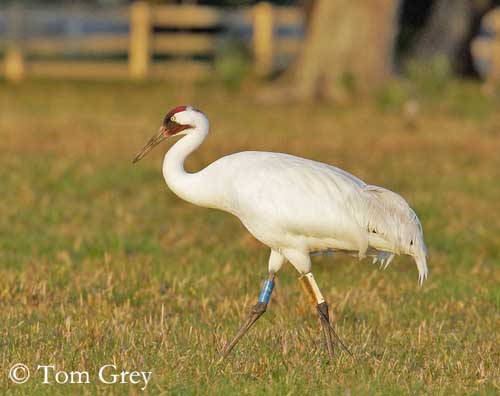
Fr: Grue blanche
All : Schreikranich
Esp : Grulla Trompetera
Ital: Gru americana
Nd: Trompetkraanvogel
Sd: Trumpetartrana
Photographers:
Jean Michel Fenerole
Photos d’Oiseaux du monde
Tom Grey
Tom Grey's Bird Pictures
Ken Havard
My Bird Gallery & Flickr gallery 1 & Flickr gallery 2
Text by Nicole Bouglouan
Sources:
HANDBOOK OF THE BIRDS OF THE WORLD Volume 3 by Josep del Hoyo-Andrew Elliott-Jordi Sargatal - Lynx Edicions - ISBN : 8487334202
FIELD GUIDE TO THE BIRDS OF NORTH AMERICA - National Geographic Society - ISBN: 0792274512
BirdLife International (BirdLife International)
International Crane Foundation
The adult has pure white plumage overall, except the black primary flight feathers and the alulae, more visible in flight.
On the head, the crown is dark red and unfeathered. The face is blackish to dark red, with elongated malar stripe contrasting with the white plumage.
The long, strong bill is horn-coloured. The eyes are pale yellow. Legs and feet are dark grey to blackish.
Both sexes are similar in plumage, but the male is larger than the female.
The juvenile has feathered pale brown head. Its body is mottled white and cinnamon.
VOICE: SOUNDS BY XENO-CANTO
The Whooping Crane utters shrill, loud, trumpeting calls “ker-loo ker-lee-loo”.

HABITAT:
The Whooping Crane was formerly breeding in the wetlands on the northern plains and in the prairies of North America.
The birds of the small wild populations breed in drier areas with mixed habitats, ponds, marshes, moorlands and forest. The nesting areas have emergent vegetation such as cat-tail and sedges.
During the migrations, they feed and roost in marshes and other wetlands and croplands.
The wintering grounds provide them brackish bays, salt flats and coastal marshes.
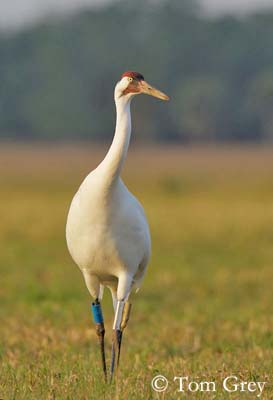
RANGE:
The Whooping Crane is a North American species living in very restricted range.
A sparse wild population breeds in Alberta (Wood Buffalo National Park) in freshwater marshes, and winters on Texas coast of Gulf of Mexico.
A small introduced flock occurs in Rocky Mountains, and frequents the intermountain wetlands.
A second experimental flock is established in Florida, using savannahs, wet meadows, marshes and lakes margins of Kissimmee Prairie region. This flock is non-migratory.
BEHAVIOUR:
The Whooping Crane is omnivorous. During the summer, it feeds on insects, fish, frogs, small birds and rodents, and also berries.
During the migration, it consumes tubers and waste grain.
On the wintering grounds, it feeds mainly on animal food such as blue crabs and clams. They also may forage in uplands where they find acorns and invertebrates.
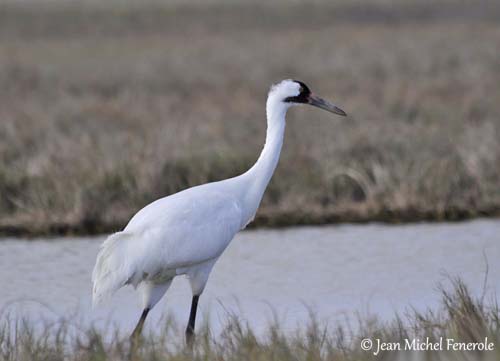
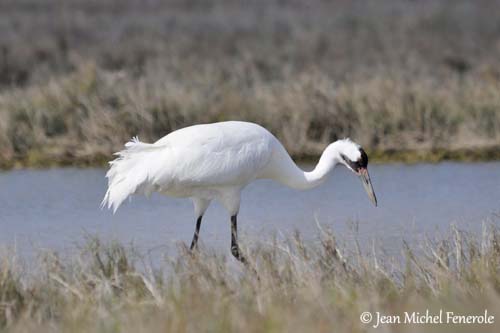
REPRODUCTION:
The Whooping Crane breeds in spring with the laying from late April to mid-May.
It breeds in wetlands. The nest is made with aquatic vegetation and is placed on the ground but up to 45-50 cm above the water level.
The female lays two eggs. The incubation lasts 28-31 days, shared by both parents, but mainly by the female. The chicks are covered in cinnamon-brown down above, and pale grey below. They are fed by both adults. They follow their parents to the foraging areas very soon after hatching. They fledge at 80-90 days and remain in family groups until the following breeding season. They are sexually mature at 3-4 years.
DIET:
The Whooping Crane is omnivorous and feeds on insects, small fish, frogs, small birds and rodents during summer. It consumes tubers and waste grain during the migrations, and on the wintering coastal grounds, it feeds on blue crabs and clams, and takes acorns and invertebrates when foraging in uplands.
PROTECTION / THREATS / STATUS:
The Whooping Crane is en Endangered species. The population is small and lives in very restricted range after decline due to habitat loss, over-hunting and human disturbances with in addition, collisions with power lines and predation of eggs and chicks.
Reintroduced small flocks in Rocky Mountains and in Florida are slowly increasing and might become self-sustaining.
The conservation status of this species is improving, allowing the hope of a downlisting to Vulnerable.
But currently, the Whooping Crane is still listened as Critically Endangered.

The Whooping Crane feeds by walking slowly on the ground or in shallow water. It probes the soil with its long bill or pecks at the surface. In the water, it can submerge the head to reach a fish under the surface.
Before the migration towards the breeding areas, the Whooping Cranes start to perform some displays such as dances while calling and also flights.
They arrive in April and usually, the pairs return to the same nesting site year after year. The courtship displays are those of all the Gruidae species, consisting in bowing, jumping, running and tossing plant items into the air while calling loudly.
The Whooping Cranes are monogamous and usually the pair-bonds are for life.
FLIGHT:
The Whooping Crane runs on the ground before to take off. It flies with deep, strong wing beats, and also uses thermals for soaring. It alights in standing stance on the ground or in shallow water.
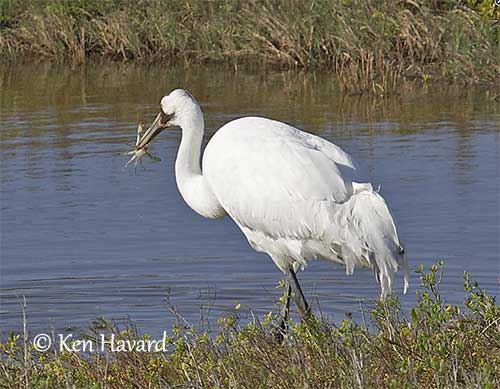
Whooping Crane
Grus americana
Gruiforme Order – Gruidae Family
BIOMETRICS:
Length: 130-160 cm
Wingspan: 200-230 cm
Weight: 4500-8500 g
DESCRIPTION:
The Whooping Crane is an Endangered species with very small population. Currently, two reintroduced flocks are increasing slowly and maybe in the future, the species will become “only” Vulnerable.
